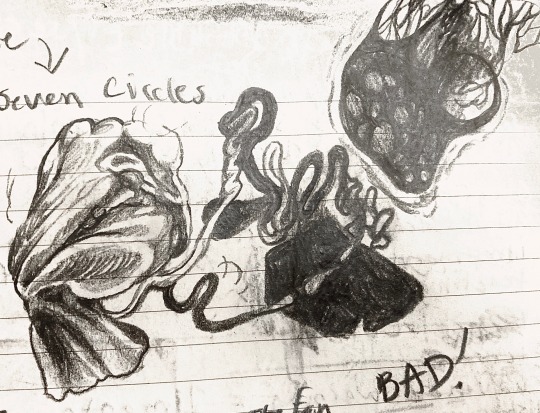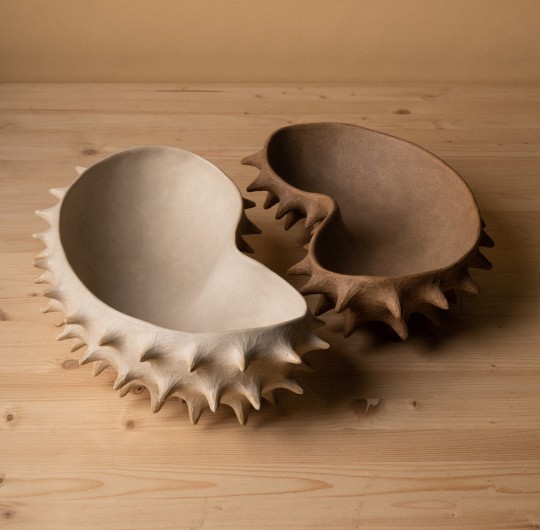#organic matter
Text






#my doodles#traditonal art#pencil#hands#body horror#abstract#creature#automatism#anxiety art#wood#absurdism#goop#organic matter
509 notes
·
View notes
Text

It was assumed that the captain of the vessel in ‘The Tame Green Hither’ exited the ship in order to prevent the Unthings from commandeering it and going to more populated parts of the Cosmos.
The fact that the captain appeared to be wholly intact rather than simply a skeleton, because there’s nothing in space to eat away organic matter.
#Inspector Spacetime#60th Anniversary Specials#The Tame Green Hither (special)#making assumptions#the ship's captain#exited the ship#in order to prevent#the Unthings (creatures)#from commandeering it#going to more populated parts of#the Cosmos#the captain was remarkably intact#not a skeleton#because in space#there's nothing to eat away#organic matter
2 notes
·
View notes
Text
youtube
Watch the American Climate Leadership Awards 2024 now: https://youtu.be/bWiW4Rp8vF0?feature=shared
The American Climate Leadership Awards 2024 broadcast recording is now available on ecoAmerica's YouTube channel for viewers to be inspired by active climate leaders. Watch to find out which finalist received the $50,000 grand prize! Hosted by Vanessa Hauc and featuring Bill McKibben and Katharine Hayhoe!
#ACLA24#ACLA24Leaders#youtube#youtube video#climate leaders#climate solutions#climate action#climate and environment#climate#climate change#climate and health#climate blog#climate justice#climate news#weather and climate#environmental news#environment#environmental awareness#environment and health#environmental#environmental issues#environmental justice#environment protection#environmental health#Youtube
7K notes
·
View notes
Photo

LEMON DROPZ - Alhambra, CA
3 notes
·
View notes
Text
Inorganic phosphate is rapidly incorporated as a nutrient by algae, leading to excess algal growth, which can overwhelm a lake with decaying organic matter.
"Chemistry" 2e - Blackman, A., Bottle, S., Schmid, S., Mocerino, M., Wille, U.
#book quote#chemistry#nonfiction#textbook#phosphorus#phosphate#inorganic chemistry#plant nutrition#algal growth#algae#overwhelmed#lake#waterways#eutrophication#decay#organic matter
0 notes
Text

Magic of Biomolecules: Building Blocks of Life in Your Soil
In the intricate realm of soil science, an often-overlooked marvel plays a pivotal role – Biomolecules. These minuscule powerhouses operate quietly beneath the surface, influencing the soil's health and, consequently, the prosperity of crops. Let's explore the domain of Biomolecules, delving into their nature, functions, and significance in the agricultural landscape.
1 note
·
View note
Text
SOIL COMPOSITION TEST – IN A JAR
The ideal ratio of the three mineral components of soil is about 40 per cent sand, 40 per cent silt and 20 per cent clay.
Sandy soil can drain nutrients more quickly, as water passes through it faster. Clay soil can be too dense to allow much of the vital air that soil life needs, and can get more waterlogged – though all of that is also dependent on soil life.
To see how your soil stacks up in terms of general sand, silt and clay composition is really easy. All you need is a jar, water and a ruler.
Find a large, tall, straight-sided jar that has a lid; ideally the jar should be about 1 litre (4 cup) capacity. Dig up soil from the patch you want to test, discarding the organic matter (sticks, dead grass and the like) right on the top. You want to test your soil right down to about 20 centimetres (8 inches) below the surface, so dig an evenly deep hole and mix up the soil in a bucket, taking multiple samples if you want to get a broad idea of your garden. As you mix the soil up, discard any rocks or large pieces of organic matter.
Fill your jar about one-third to half full with soil. Add enough water to come about nine-tenths up the side of the jar, leaving enough room to be able to shake it. Add half a teaspoon of dishwashing detergent if you have it, to help separate the soil components. Pop the lid on and shake the jar well for about three minutes.
Leave the jar on a bench, undisturbed, for a day or so. After that time, you'll find that the jar contents will have separated into layers. On the surface of the water will be organic matter. Below that, there should be water, probably discoloured with dissolved organic matter. The next layer down is clay, below that is silt – and below that is sand which, being heavier, should have sunk to the bottom.
Use a ruler to measure the total volume of the sediment, and the depth of each layer of minerals. For instance, if you have a total height of 10 cm (4 inches) of settled soil in the jar, you may find that the silt is 4.5 cm, the clay 1.5 cm, and the sand 4 cm. Convert each of these to a percentage by taking each layer, dividing it by the total height, then multiplying by 100. In my example, 1.5 cm of clay would be 1.5 ÷ 10 × 100 = 15%. So clay would be 15% of my soil.
The U.S. Department of Agriculture has a fabulous soil pyramid to calculate the type of soil you have from these percentages – see http://tinyurl.com/soilcalc
The jar test is really handy for a quick, free analysis of what your general soil type is like. It's your own personal starting point. But remember, decayed organic matter and invisible life in soil can alter the way these minerals behave, because carbon and soil biology give soil structure, and can make minerals more available to plants. So, just because you don't have the ideal ratio, doesn't mean you can't grow great things. Regardless of ratios, soil life is fundamental, and should be the goal of all growers, no matter what the location.
"Soil: The incredible story of what keeps the earth, and us, healthy" - Matthew Evans
#book quotes#soil#matthew evans#nonfiction#soil composition#jar test#sand#silt#clay#experiment#science experiment#us department of agriculture#soil biology#soil culture#organic matter#sediment
0 notes
Text
The way young people appreciate tea starts with "smelling the aroma"

Spring tea is a type of tea made from the buds and leaves of tea plants that have sprouted after winter dormancy. After a winter of rest and nutrient accumulation, the tea buds have ample organic matter and the moderate temperature and sufficient rainfall in spring make the buds plump with high freshness, fullness, and coordination.
Processing of spring tea used to be a sign of maturity, but now it is capturing the hearts of young people. When young people drink tea, they may not have too many requirements and do not need too much tea ware, just a cup or a pot and a day's leisure time. If there is sunshine or a sense of ceremonial atmosphere to enhance social interaction, everything will be perfect. However, for friends who want to improve their tea tasting, they do not need hardware, they just need to know how to "smell."
Each type of tea has its own unique aroma, which is influenced by the tea plant variety (variety fragrance), the growing region and environment (region fragrance), and the production and processing technology (processing). Therefore, the aroma of tea on the market can be divided into the following categories, and everyone can collect them for future tea tasting.
Floral aroma
The tea emits a fragrance similar to that of fresh flowers. It can be further divided into clear floral and sweet floral types. The clear floral type is more elegant, such as orchid fragrance and honeysuckle fragrance, while the sweet floral type is more rich, such as osmanthus fragrance and rose fragrance.
Representative tea types: jasmine tea, Keemun black tea, etc.
Furry aroma
The aroma of the tea made from the buds and leaves with more fuzz is a type of plant tender flavor.
Representative tea types: Silver Needle white tea, Huangshan Maofeng green tea, etc.
Woody aroma
The aroma contains a fiber smell and sweetness, especially the aged ripe tea has a clear woody aroma. In addition, this flavor may also exist in some newly fermented but unsuccessful ripe teas.

Representative tea types: Yunnan Pu'er tea, Zhengshan Xiaozhong black tea, etc.
Smoky aroma
Tea leaves that are older and contain more stems, such as high smoke, old smoke, and pot smoke, have high-temperature baking during processing, which causes the caramelization of sugar substances.
Representative tea types: Wuyi Rock tea, Huoshan Huangda tea, etc.
Fruity aroma
The tea emits a fragrance similar to that of fruits, such as peach, snow pear, Buddha's hand, orange, pineapple, apple, longan, etc.
Representative tea types: Minbei Oolong tea, Dianhong black tea, etc.
Sweet aroma
It generally includes clear sweet, sweet floral, sweet fruity, honey, and caramel aromas, which are more common in heavily fermented and baked teas.
Representative tea types: Keemun black tea, Phoenix single bush tea, etc.
Clear aroma
Tea with a relatively low degree of killing, kneading, fermenting, and roasting will produce a clear aroma, with less human intervention during processing.
Representative tea types: Zhuye Qing green tea, Mengding Ganlu green tea, etc.
Aged aroma / Mellow aroma
The unique fermentation process of dark tea gives its tea flavor a different aroma from other teas, and the longer it is stored, the more mellow the aged aroma becomes.
Representative tea types: Guangxi Liubao tea, Anhua dark tea, etc.
Pine smoke aroma
Tea leaves dried using pine chips during the drying process will have a distinct pine smoke aroma.
Representative tea types: Tongmuguan black tea, Zhengshan Xiaozhong black tea, etc.
In fact, many times the aroma of tea often presents a comprehensive mix. Zhang Jing, honorary chairman of the Sichuan Tea Culture Association, believes that tea has the charm of "winning people with fragrance." Fragrance is the first impression that consumers have of tea. Young people should start with smelling when learning about tea, and then deepen their understanding of tea through tea art and aftertaste.
To identify and evaluate tea aroma, you can start by remembering the tea aromas with clear analysis. Generally, the less fermented tea that is killed early, such as green tea, has a relatively simple aroma, which is easier to distinguish. As the olfactory memory bank deepens impressions and supplements more different flavors, the ability to identify multi-flavored tea aromas will improve, which is training the sensitivity of the mouth and nose to aromas.
#Spring tea#Drink tea#Young people#Tea set#Smell#Aroma#Tea plant#Tea leaves and buds#Wintering#Nutrients#Organic matter#Temperature#Rainfall#Freshness#Fullness#Coordination#Processing#Variety aroma#Regional aroma#Crafting#Floral aroma#Light floral aroma#Sweet floral aroma#Jasmine tea#Keemun black tea#Tippy aroma#Bai Hao Yinzhen (Silver Needle) tea#Huangshan Maofeng tea#Woody aroma#Yunnan Pu-erh tea
1 note
·
View note
Text
How does one determine the pH level of their soil and adjust it accordingly for optimal plant growth?
Soil pH is an important factor in plant growth and health. The pH level of the soil determines how well plants can absorb nutrients from the soil. Most plants prefer a slightly acidic soil, with a pH between 6.0 and 7.0. If the soil is too acidic or alkaline, it can negatively affect plant growth and development. In this article, we will discuss how to determine the pH level of your soil and…

View On WordPress
#acid-loving plants#acidic soil#alkaline soil#alkaline-loving plants#compost#fertility#garden center#leaf mold#lime#manure#natural soil amendments#nutrient absorption#optimal plant health.#organic matter#pH-adjusted fertilizers#plant growth#soil health#soil pH#soil testing#sulfur
1 note
·
View note
Photo

Amorphous Ceramic Vessels by Julie Bergeron Merge the Shapes and Textures of Organic Matter
All images by Alain Delorme, © Julie Bergeron




#julie bergeron#artist#artt#ceramic sculptures#organic matter#shapes#texture#alain delorme#photographer
1 note
·
View note
Text
Bacteria and Decay
The life of bacteria is built around food. These micro-organisms don’t have traditional mouths to feed, but they eat, they digest, and they excrete waste as they break down their food into its more elemental components to facilitate absoBacteria and Decay
The life of bacteria is built around food. These micro-organisms don’t have traditional mouths to feed, but they eat, they digest, and they excrete waste as they break down their food into its more elemental components to facilitate absorption. We need decay to break down dead matter into basic substances to provide nutrients for new plants, to feed our soil, and promote life.
Unlike bacteria,…

View On WordPress
#Bacteria#decay#decompose#excrete waste#f ungi#micro-organism#microbes#organic matter#unicellular organism
1 note
·
View note
Text
Mars rover finds organic matter
Mars rover finds organic matter
NASA’s Perseverance Rover has found organic matter in rocks on Mars after just a year and a half on the planet. NASA held a press briefing on Thursday, Sept. 15 to discuss.
Perseverance, nicknamed Percy, found the matter within an ancient river delta in the Jezero Crater. The sedimentary rock which the samples were taken likely formed billions of years ago from mud and sand settling in a salt…

View On WordPress
0 notes
Text
Today, we added some more organic matter in the form of leaves be collected last fall:

And also spread some Pearly Everlasting seeds, a native plant that does well in dry, sunny conditions, and is also appreciated by some of the native bumblebee species:

These were collected from one of my job sites- certainly a bonus of helping people incorporate native species into their yard is that now I have a source for native seeds & plant divisions!
0 notes
Text
Version that doesn't require sign-in.
"Hot Labor Summer just became a scorcher.
[On August 25, 2023], the National Labor Relations Board released its most important ruling in many decades. In a party-line decision in Cemex Construction Materials Pacific, LLC, the Board ruled that when a majority of a company’s employees file union affiliation cards, the employer can either voluntarily recognize their union or, if not, ask the Board to run a union recognition election. If, in the run-up to or during that election, the employer commits an unfair labor practice, such as illegally firing pro-union workers (which has become routine in nearly every such election over the past 40 years, as the penalties have been negligible), the Board will order the employer to recognize the union and enter forthwith [a.k.a. immediately] into bargaining.
The Cemex decision was preceded by another, one day earlier, in which the Board, also along party lines, set out rules for representation elections which required them to be held promptly after the Board had been asked to conduct them, curtailing employers’ ability to delay them, often indefinitely.
Taken together, this one-two punch effectively makes union organizing possible again, after decades in which unpunished employer illegality was the most decisive factor in reducing the nation’s rate of private-sector unionization from roughly 35 percent to the bare 6 percent at which it stands today...
“This is a sea change, a home run for workers,” said Brian Petruska, an attorney for the Laborers Union who authored a 2017 law review article on how to effectively restore to workers their right to collective bargaining enshrined in the 1935 National Labor Relations Act, which was all but nullified by the act’s weakening over the past half-century. Taken together, Petruska added, last week’s decisions recreate “a system with no tolerance for employers’ coercion of their employees” when their employees seek their legal right to collective bargaining...
Since the days of Lyndon Johnson, every time that the Democrats have controlled the White House and both houses of Congress, they’ve tried to put some teeth back into the steadily more toothless NLRA. But they’ve never managed to muster the 60 votes needed to get those measures through the Senate. The Cemex ruling actually goes beyond much of what was proposed in those never-enacted bills."
-via The American Prospect, August 28, 2023
--
Note: I didn't include it because the paragraphs about it went super into the weeds, but the reason all of this is happening is because of the NRLB's general counsel, Jennifer Abruzzo, who was appointed by Biden. In fact, according to this article, this "secures Abruzzo’s place as the most important public official to secure American workers’ rights since New York Sen. Robert Wagner, who authored the NLRA in 1935." Voting matters
#labor#labor rights#labor unions#workers rights#unions#unionize#nlrb#national labor relations board#biden#biden administration#united states#us politics#voting matters#american politics#organized labor#union busting#good news#hope#hope posting#hot labor summer#pro union
1K notes
·
View notes
Text




#columbo#season 2#double shock#mrs peck ysee im literally neurodivergent and a minor#columbo very competently weaponizes his dysfunction. he doesn't make it up. it's not An Act. he simply leverages whats already there#hes tried labeling. closet organizers. shelving drawers devices etc etc forever and ever and it doesnt matter. he is just entropy incarnate#and he's made peace with it. and so has his wife who presumably accepts bringing order to his lack thereof
802 notes
·
View notes
Text
Most gases and liquids consist of molecules, and most solids based on carbon (organic solids) are also molecular.
"Chemistry" 2e - Blackman, A., Bottle, S., Schmid, S., Mocerino, M., Wille, U.
0 notes
Text
The Earth's oceans are extremely complex chemical systems, comprising vast quantities of dissolved inorganic salts, dissolved organic matter and dissolved gases.
"Chemistry" 2e - Blackman, A., Bottle, S., Schmid, S., Mocerino, M., Wille, U.
#book quotes#chemistry#nonfiction#textbook#earth#ocean#dissolved#inorganic chemistry#salts#organic matter#gases
0 notes